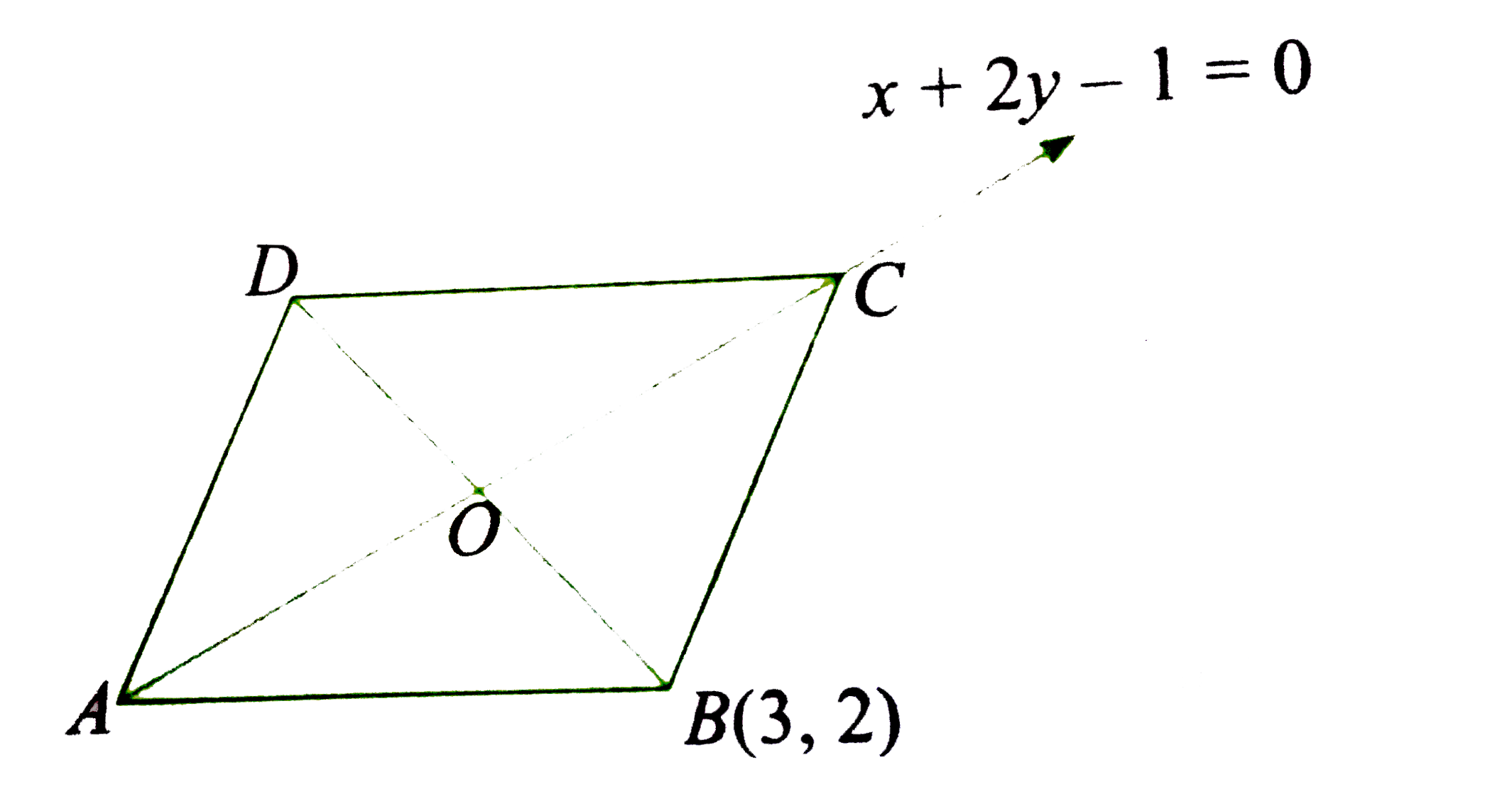A diagonal of rhombus ABCD is member of both the families of lines (x+y−1)+λ(2x+3y−2)=0 and rhombus is (3, 2). If the area of the rhombus is 12√5 sq. units, then find the remaining vertices of the rhombus.

Since diagonal is member of both the given families of line, it will pass through the points (1,0) and (-1,1) which are points where given family of lines are concurrent.
So, equation of diagonal AC is x+2y-1=0.
Clearly, point (3,2) does not satisfy this diagonal.
∴LetB≡(3,2).
Diagonal BD is perpendicular to AC.
So, equation of diagonal BD is 2x-y-4=0.
Point of intersection of diagonal AC and BD is O (95,−25).
Since O is midpoint of BD, D ≡(35,−145).
Now,OD=6√5.So,BD=12√5=d1
Area of rhombus =12d1×d2=12√5 (where d2 is length of diagonal AC)
∴d2=10 units
This is the length of diagonal AC.
Slope of AC =−12=tanθ,whereθ is inclination of AC with x-axis.
Since OA=OC=5, using parametic from of straight line, we have
A,C≡(95±5cosθ,−25±5sinθ)
≡(95±5(−2√5),−25±5(1√5))
≡(95−2√5,−25+√5),(95+2√5,−25−√5)
Topper's Solved these Questions
- BOOK - CENGAGECHAPTER - STRAIGHT LINESEXERCISE - Exercise 2.123videos
STRAIGHT LINES
- BOOK - CENGAGECHAPTER - STRAIGHT LINESEXERCISE - Exercise 2.24videos
STRAIGHT LINES
- BOOK - CENGAGECHAPTER - STRAIGHT LINEEXERCISE - Multiple Correct Answers Type8videos
STRAIGHT LINE
- BOOK - CENGAGECHAPTER - THEORY OF EQUATIONSEXERCISE - JEE Advanced Previous Year9videos
THEORY OF EQUATIONS
Similar Questions
A diagonal of rhombus ABCD is member of both the families of lines (x+y−1)+λ(2x+3y−2)=0and (x−y+2)+λ(2x−3y+5)=0 and rhombus is (3, 2). If the area of the rhombus is 12√5 sq. units, then find the remaining vertices of the rhombus.
View SolutionIf the area of a rhombus is 24cm2 and one of its diagonals is 4 cm, find the perimeter of the rhombus.
View Solution
Knowledge Check
- Question 1 - Select One
The area of a rhombus is 120cm2 and one of its diagonals is 24 cm. Each side of the rhombus is
A10 cmB13 cmC12 cmD15 cm - Question 2 - Select One
If the area of the rhombus enclosed by the lines x±y±n=0 be 2 square units, then
An2=4Bn2=2Cn2=12Dn2=1 - Question 3 - Select One
If the side of a rhombus is 10cm and one diagonal is 16cm, then area of the rhombus is
A24cm2B48cm2C72cm2D96cm2
A diagonal of rhombus ABCD is a member of both the family of lines (x+y+1)+λ1(2x+3y−2)=0and(x−y+2)+λ2(2x−3y+5) where λ1,λ2∈ R and one of the vertex of the rhombus is (3,2) . If area of the rhombus is 2√5 square units then find the length of semi longer diagonal of the rhombus ..........
View SolutionThe area of a rhombus is 441cm2 and its height is 17.5 cm. Find the length of each side of the rhombus.
View SolutionThe area of a rhombus is 220.5 cm2 .If its altitude is 17.5 cm, then find the length of each side of rhombus.
View SolutionThe area of the rhombus ABCD is 24. The equation of the diagonal BD is 4x + 3y + 2=0 and A (3,2) The length of the side of the rhombus is
View SolutionIn a rhombus PQRS , PR and QR are the diagonals of the rhombus. If PQ=10cm, then find the value of PR2+QS2.
View Solution
